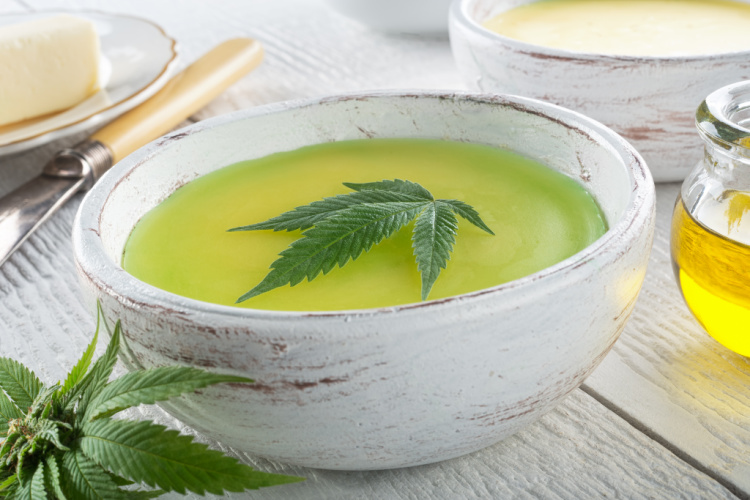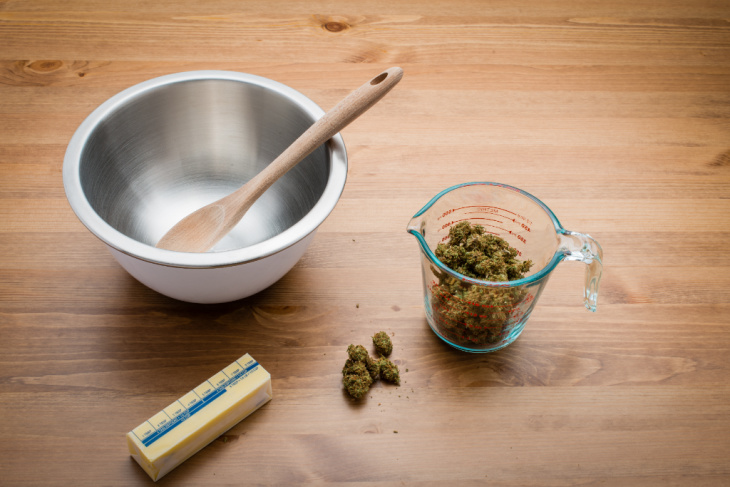If you’re at all curious about the wide world of cannabis edibles, you’ve likely heard about cannabutter, the main ingredient in many infused treats and tasty goodies. A favorite among cannabis chefs, bakers, and medical patients, it’s easy to make and versatile, providing a basic building block for a variety of cannabis edibles. Regardless of your experience level, there’s no need to be afraid to dive in and get cooking.
Though you can make potent cannabutter with extracts, we suggest starting things off with good ol’ fashioned cannabis flower. No need to be intimidated—simply follow our easy guide to making flower-infused butter. You’ll get the full scoop on measurements and dosage, decarboxylation, and so much more!
How to Make Cannabutter With Cannabis Flower
Making cannabutter with cannabis flower requires a few necessary materials and ingredients to bring the recipe to life. The most important one you’ll need? High-quality cannabis flower—especially if your main priority is to preserve the plant’s unique terpenes—the aromatic compounds found in cannabis—or to highlight the potency of the final edible product.

Thankfully, we’ve got you covered. Before getting started, browse your dispensary’s menu to find your favorite strains or load up on fresh, new cultivars. Depending on your desired potency level, you can choose exactly how much flower will go into your cannabutter recipe. If you’re dealing with a strain of average potency (say 20% THC), here’s what we recommend to get you started:
- 1 gram cannabis flower to 1 pound of butter for lower potency edibles
- 2 grams cannabis flower to one pound of butter for medium to high potency edibles
- 3 grams cannabis flower to one pound of butter for high-potency edibles
As you learn to adjust and experiment with your preferred potency levels, these measurements will vary, but they’re a good rule of thumb to follow if you’re a beginner or just need a bit more direction.
Ingredients and Materials
Ready to get cooking? This cannabutter recipe will require an oven and stovetop. Gather these ingredients and materials to make quality cannabutter:
- 1 gram cannabis flower
- 1 cup unsalted butter
- Cannabis grinder or kitchen knife
- Baking sheet
- Parchment paper
- Saucepan
- Kitchen thermometer
- Mesh strainer
- Glass container
Got everything you need? Great! Let’s start decarboxylating your flower.
Decarboxylating Cannabis: What is it and Why is it Important?
The first step to making any type of edible, decarboxylation is a simple process that involves converting the non-psychoactive cannabinoid THCA into usable THC using gentle heat. It’s the necessary step to ensuring that your edibles deliver all of THC’s effects and goodness in a mouthwatering package.
Decarboxylating your flower before infusing it into butter will ensure that most of its available THC is extracted. The trick is not to heat your flower too much or for too long—you don’t want to burn off the plants’ other beneficial compounds, like its flavonoids and terpenes, which are more sensitive to higher temperatures.
How to Decarb Cannabis
This is how to properly decarb your cannabis flower:
- Preheat oven to 220℉.
- Grind cannabis flower with a cannabis grinder or kitchen knife to expose as much of its surface area as possible. This will enable the heat from your oven to hit the cannabis flower from every angle and decarboxylate it completely.
- Place parchment paper on a baking sheet and evenly spread the ground cannabis flower over it
- Place the baking sheet into the oven and bake at 220℉ for about 30 minutes, checking it halfway through.
- Remove the baking sheet from the oven when your cannabis flower begins to look lightly toasted and dry. Allow to cool.
That’s it! You now have useable, decarboxylated cannabis for your cannabutter recipe.
How to Make Cannabutter: Step-by-Step Recipe
Cooking cannabutter can be a bit time-consuming—especially when you’re making it for the first time. But trust us: It’s well worth the effort and wait. Here’s our step-by-step recipe for making potent cannabutter:
- Decarboxylate your desired amount of cannabis flower—we recommend using 1 gram of average potency (20% THC) flower if it’s your first time making cannabutter. Set aside.
- Melt the unsalted butter (roughly 2 sticks) in a saucepan on low heat or consider using a vegan oil, such as coconut oil, if you would prefer not to use butter. Olive oil is also fine, though you might get better results with a neutral cooking oil, such as sunflower oil, grapeseed oil, or products labeled “vegetable oil.”
- Add your decarboxylated cannabis flower to the melted butter and let it simmer gently on low heat for 2 – 3 hours, stirring occasionally.
- Use your kitchen thermometer to ensure the temperature of the butter (or oil) doesn’t exceed 210°F to avoid burning off the precious cannabinoids and other beneficial compounds found in cannabis flower.
- Remove cannabis/butter mixture from the stove. Pour into a mesh strainer over a glass container, such as a mason jar.
- Allow to cool.
- Place the glass container in the refrigerator if you’ll be using it within a few days to a couple of weeks, or store for up to 4 – 6 months in the freezer.
From here, it’s up to you to whip up some delicious homemade edibles. You can incorporate this cannabutter into many recipes, from infused brownies, cookies, and cakes, to chicken wings, pasta sauce, and grilled mashed potatoes! When it comes to cannabutter, the sky is truly the limit.
Crunched for Time? Here’s a Quicker Way to Make Cannabutter
We highly suggest using the low and slow infusion process outlined above since it will yield the highest potency cannabis-infused butter possible.
But if you’re in a hurry and can’t wait the several hours needed to produce traditionally-made cannabutter, you can speed up the process by adding water to the mix and working with a higher stovetop temperature, though the risk of burning off the flower’s other compounds is much higher.

Instead of 2 – 3 hours of wait time, you can expect to have a batch of buzzy cannabutter in under an hour with these steps:
- Decarboxylate your raw flower, as outlined above, but reduce the quantity to ¼ gram.
- Melt about ¼ stick of unsalted butter and ¼ cup water in a saucepan on low-medium heat.
- Add your decarboxylated cannabis flower to the saucepan and mix it with your melted butter before letting it cook for 2 – 4 minutes. Turn the burner down to low and simmer for about 45 minutes.
- Remove from the stove and allow the cannabutter to cool and harden.
- Store in the refrigerator or freezer.
Though you may notice a difference in the potency of your homemade cannabis when you use the slower cooking method, there is nothing wrong with speeding up the recipe if you’re ever in a bind and need cannabutter fast. Bon appetit!
How to Properly Dose Cannabutter for Cannabis Edibles
Calculating the right cannabis dosage for your edibles can feel a bit daunting and will depend on whether you use flower or concentrate. For flower, think of calculating the dosage like this:
- There are 1,000 milligrams in a gram. So, if you use 3 grams of cannabis to make your cannabutter, that’s 3,000 milligrams.
- Next, multiply the total milligrams of cannabis by the THC percentage. If your cannabis has 20% THC, 3,000 mg x 0.20 = 600 mg of total THC.
- Finally, divide the total THC by the number of servings in your recipe. If you’re making a batch of 15 infused cookies, then 600 mg ÷ 15 = 40 mg of THC per cookie.
You can experiment with adding less or more amounts of cannabis flower or concentrates when making cannabutter to make it less or more potent. Changing the amount of cannabis flower in cannabutter may affect the onset time and duration of the effects. But regardless of potency, most studies suggest you won’t feel the effects of cannabis from edibles for anywhere between 30 minutes and two hours and may not experience peak effects for up to three hours.
Follow the Golden Rule
Remember: We all react to cannabis differently. When in doubt, shoot for a lower potency than a higher one. Why? When we consume cannabis edibles, the cannabinoids are processed through the stomach and liver rather than the lungs, and compared with a similar amount of inhaled cannabis, the cannabinoids in edibles can feel stronger and last far longer. We’re talking as long as 6 to 12 hours as opposed to 2 to 4 hours!
Follow the golden rule: start low and go slow.
Best Tips and Tricks for Making Cannabutter
Still feeling nervous about making cannabutter on your own? Don’t be! Though we know it’s much easier said than done, here’s a list of tips and tricks you can use to make your first cannabutter experience a complete success:
- Start Low and Slow: Purchase cannabis flower from a trusted source, and don’t overdo it when it comes down to just how much flower you should add to your butter. The last thing you want to do is add too much and end up with cannabutter that’s far too potent for your needs or preferences. You can always add more next time if you find the cannabis edibles aren’t strong enough.
- Roughly Grind Your Flower: Avoid grinding up your cannabis flower into a fine powder before decarboxylation. Keeping the grind relatively rough gives you better control over keeping the plants’ beneficial compounds intact during the decarb process.
- Introduce Water to Avoid Scorching: Keep at least one cup of water at your side when cooking cannabutter. Add it to your recipe while the butter cooks. This can keep it from scorching and burning off those precious cannabinoids. In many cases, you’ll have to start over from scratch if you scorch the butter.
With our in-depth recipe and these helpful tips and tricks, it shouldn’t be long before have a fresh container of potent cannabutter ready to use at a moment’s notice.
Shop Quality Flower and Tasty Edibles at Green Goods
Ready to make your favorite infused treats and mouthwatering dishes? Start by browsing the menu at your closest Maryland or Minnesota Green Goods dispensary, load up on your favorite flower, and let’s get cooking!
Want to try an edible without all the extra effort? Explore our huge selection of gummies, chocolates, cookies, and more—all ready to eat right now! Stop by any of our locations and say hello to our friendly team, or put in a convenient pickup order.
Have more questions about infused edibles or other cannabis-related topics? Just reach out—we’re always here to help!
